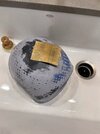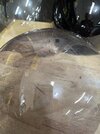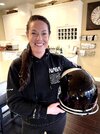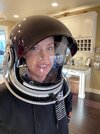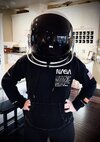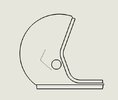Looking good. In one of the pictures you posted, there seems to be a "step" in the back of the helmet. The shell of the ACES is smooth.
The v-form pattern needs to be glass smooth. 600 grit at minimum. You cant go too smooth!
The best way I have found to smooth parts is with high-fill primers. But you have to let them dry completely, then wet sand your surfaces. Using copious amounts of water with allow you to sand faster & longer (with wet-dry sandpaper) and will give you a better finish. Do not gloss paint your pattern with a non-catalyzed paint. Rattle can paints generally get soft when heated and a gloss spray-paint is liable to stick to you hot plastic. Even with the pattern powdered with talc. (Baby powder) The high fill primers do not seem to have this issue of sticking, but you definitely want to talc your plastic and pattern first.
Also .030 PETG is way too thin. The real visor is .125" and at only .030" your visor will be very floppy. I would recommend no thinner than .060" but .090" would be better. To improver the optical quality, use the type of PETG that has a plastic film protective sheet (They may all be like this) and leave this film on your sheet (Inside) when forming. It should peal off easily after the visor has been formed. This will help with the clarity of your finished visor by keeping the removable film between your hot plastic and the tool.
It seems the early S1035 helmets has a bronze colored sun visor, and the newer Orion helmet may have a gray sun visor. So if you are doing an ACES version, the sun visor wants to be very dark bronze.
Here is a set of photos of the s1035 helmet (note the
3M- prismatic tape on the back)
View attachment 1536091

